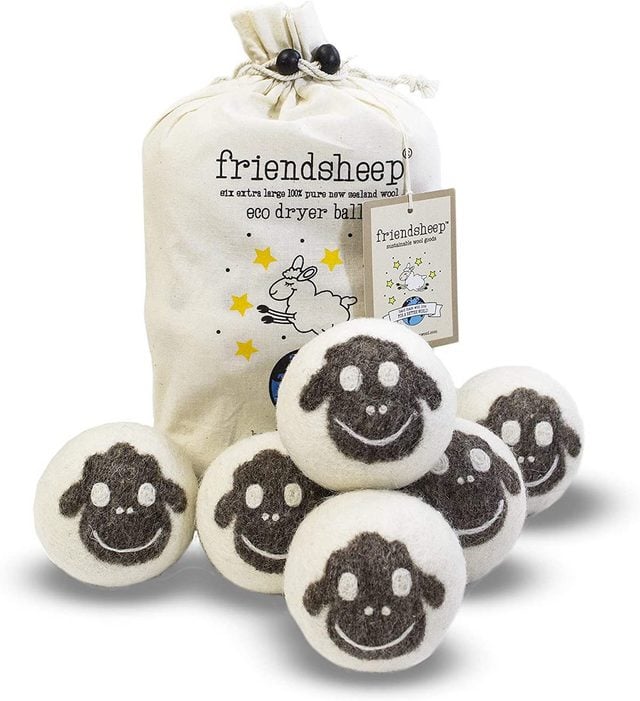How Does a Hummingbird Eat With a Long Tongue and Beak?

A casual observation might suggest that hummingbirds use their long, thin, dainty beaks like straws. However, beginning early in the 19th century, scientists realized the tip of a hummingbird’s tongue forks into two tiny tubes. So they postulated the birds must drink nectar through capillary action. This is the same mechanism that allows a towel to draw in water. Turns out, the scientists were wrong—for well more than a century.
Discover the truth about common hummingbird myths.
Only in recent years have scientists figured out how a hummingbird laps up nectar with its long, slender tongue. Inquisitive scientists and high-speed motion photography finally cracked the code in 2011. Researchers Margaret Rubega and Alejandro Rico-Guevara discovered that hummingbirds feed via a pistonlike method. They lap up nectar with their tongues. The tiny forks at the tip spring open to gather fluid. Then the tongue retracts as the bill squeezes shut, compressing the tongue and allowing the bird to lap up the nectar. They repeat this high-speed lapping 15 to 20 times per second.
How fast do hummingbirds fly and flap their wings?
Hummingbirds Reach Sugar Water With Long Tongues
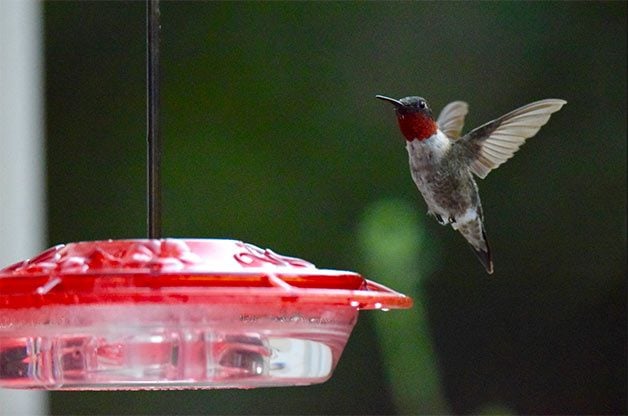
“Can hummingbirds reach far enough down to get sugar water from half full saucer feeders?” asks Birds & Blooms reader Cindee Darden of Marietta, Georgia.
Kenn and Kimberly Kaufman: Yes, they can. We often recommend the saucer style of hummingbird feeders. They’re easier to clean than some other types, and with the level of the sugar water far below the opening in the top, insects like bees can’t reach it. But hummingbirds can reach it with no problem. In addition to their long, narrow beaks, they also have long tongues that can extend far out beyond the tip of the beak. In this way they have access to the nectar deep inside long, tubular flowers. They also can reach far down into the saucer of a feeder.
Do hummingbirds mate for life?
A variety of other birds are also drawn to sugar water, including woodpeckers, orioles, tanagers, warblers and vireos. Watching them try to perch on hummingbird feeders in a manner that allows them to slide their tongue into the ports can be entertaining. Such visitors are rarely more than an inconvenience to the hummingbirds.
Where do hummingbirds sleep at night?
A Hummingbird Beak is Perfect for Pollination

Beak (bill) lengths and shapes vary dramatically throughout the hummingbird world. Some species coevolved with specific flowers that provide their primary nectar sources. Many hummingbirds have bills specifically adapted to fit certain flower species. Studies in the evolutionary relationship between pollinators, such as hummingbirds and bees, and flowers that need to be pollinated, continue to provide amazing insights.
One such research project, headed by Lena Hileman at the University of Kansas, revealed that the flowers of various penstemon species show either bee or hummingbird adaptation. Species that are adapted to bee pollination are generally bluish or purplish, with a flower tube of sufficient diameter to allow bees to enter and a stamen positioned to deposit pollen on the backs of bees. Conversely, species adapted for pollination by hummingbirds are red or orange-red with narrow openings to allow only the hummingbird’s bill and/or tongue to enter. They don’t need to offer a landing pad.
If you’ve ever wondered, this is how much hummingbirds weigh.
All this coevolution has led to some truly bizarre flowers but also to some hummingbirds with extraordinary bills. Among the most idiosyncratic is the sword-billed hummingbird, native to Andean South America. This bird’s daggerlike bill is nearly as long as its entire body, stretching to almost 4 inches. This long bill allows the sword-billed hummer to feed on long-tubed flowers whose nectar is inaccessible to other species, especially the beautiful pink blooms of northern banana passionflower.
Meet the world’s largest and smallest hummingbirds.
Can Hummingbirds Open Their Beaks?

Another enduring mystery is how they catch insects, which make up a significant and important part of their diets. Again, relying on high-speed frame-by-frame photography, researchers learned that hummers can flex their lower bill downward to get it out of the way and widen the base. Then they snap the bill closed at blinding speed. Combined with their aerial agility, this adaptation for catching insects on the wing allows hummingbirds to obtain life-sustaining protein, fat, amino acids, and other important nutrients.
Discover more jaw-dropping facts about hummingbirds.
To learn more, check out The Hummingbird Handbook: Everything You Need to Know About These Fascinating Birds, published by Timber Press.
How Much Does a Hummingbird Weigh?

Hummingbirds seem so small and delicate as they zip, dart and dash from feeders to flowers. You may wonder how much does a hummingbird weigh? A tiny hummingbird typically weighs 0.1 to 0.2 ounces (less than the weight of a marshmallow). Costa’s, like this male (above), weigh in at only one-tenth of an ounce. Their crouched posture makes them look even smaller.
Did you know: A hummingbird’s brain makes up around 4% of its body weight. It remembers every flower it visits! How do hummingbirds find feeders?
Discover even more jaw-dropping facts about hummingbirds.
Hummingbird Size
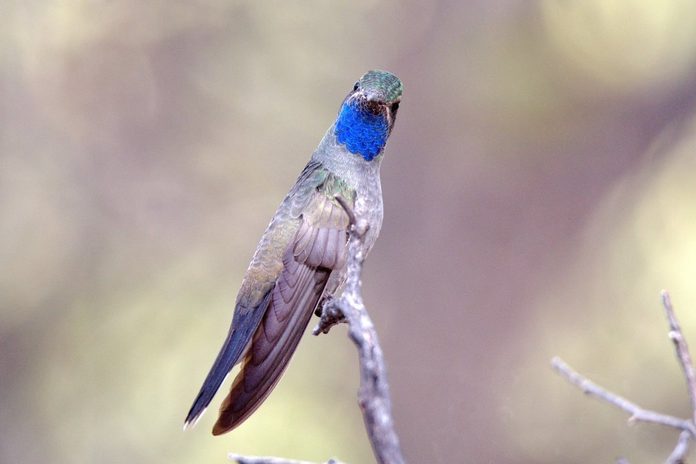
The bee hummingbird of Cuba is the smallest bird on earth, measuring only 2 inches from bill tip to tail tip. In contrast, the blue-throated hummingbird is almost the size of a sparrow. It is the largest breeding hummingbird found in the U.S.
Most types of hummingbirds measure between 3 and 4 inches. In the United States, Allen’s hummingbirds are the second smallest species after the Calliopes. Allen’s measure about 3 inches long. Anna’s hummingbirds are also quite small in size, measuring about 3.9 inches from beak to tail.
A broad-tailed hummingbird‘s tail is slightly wider and longer than that of most other hummingbirds found in the U.S. and Canada, extending beyond the wingtips when the bird is perched and resting.
Psst—if you see an insect-sized hummingbird look-alike visiting nectar flowers at dusk, it might actually be a hummingbird moth!
Meet the world’s largest and smallest hummingbirds.
Bill Length

“After watching hummingbirds at my feeders, I noticed that males put their bills farther into the sugar water than females. Do females have longer bills?” asks Birds & Blooms reader Pat Comack of Hazelwood, Missouri.
Kenn and Kimberly Kaufman: That’s an interesting observation! Female ruby-throated hummingbirds do have a slightly longer bill, on average, than males. The difference is so minor—less than one-tenth of an inch— that most people would never notice. The females also average slightly larger bills overall.
Learn how hummingbirds use their tongues and beaks.
Warblers are some of the most exciting birds to see during spring migration. These colorful spring birds leave their warm wintering grounds south of the border in Central and South America and migrate up to the norther parts of the country. Although warblers are tiny, their brightly colored feathers make them stand out as they flit from branch to branch, hunting insects.
There are over 50 species of warblers in the United States and Canada, but most warblers don’t visit backyards, because they aren’t feeder birds and typically stick to forested areas. We rounded up 20 types of warblers you might see this spring. But there are many more warbler species to photograph and identify, so make sure you keep your camera, binoculars and field guides handy!
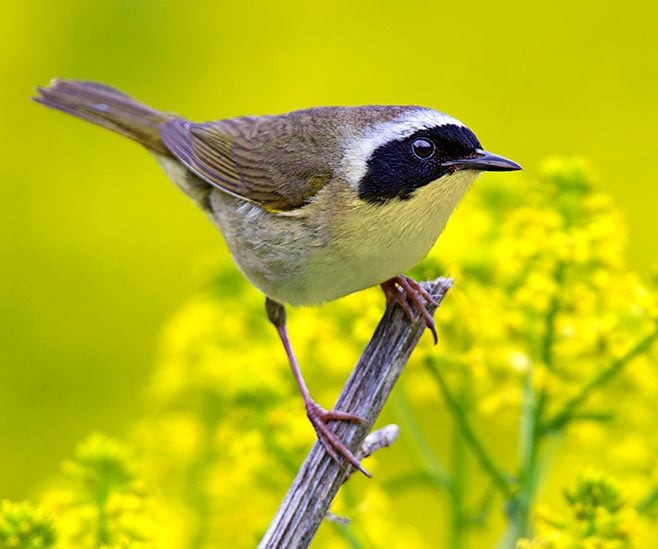
1. Common Yellowthroat
It’s worth a visit to a marshy area for a quick look at common yellowthroats. Although they try to remain out of sight, they flit in and out of reeds and cattails. Listen for the wichity-wichity-wichity song from mashes, and look for the male’s distinct black mask.
Check out 25 small yellow birds you should know.
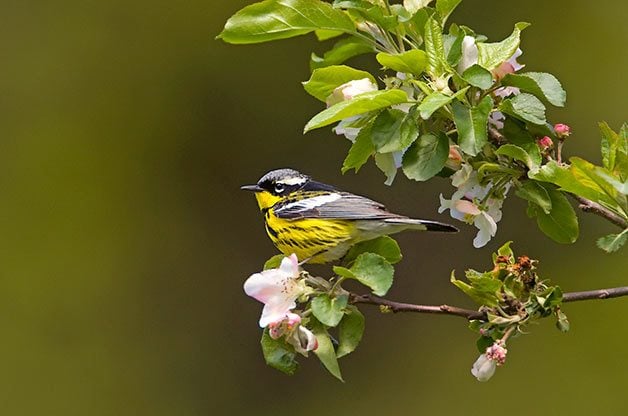
2. Magnolia Warbler
This easy-to-spot warbler spends time in low shrubs and small trees. During spring migration, magnolia warblers zip through the eastern half of the U.S. on the way to their breeding grounds in Canada and in northern states like Minnesota and Wisconsin.
Meet the colorful Canada warbler.

3. American Redstart
Bright yellow plumage is common among warblers. But the male American redstart, covered in mostly black, breaks all the rules. Their bold patterns and behaviors are impossible to miss. Redstarts are among the most active warblers, showing off orange-red patches as they flit through trees. Be on the lookout for redstarts if you’re birding on eastern forest edges.
American redstarts stand out, not just for their brilliantly bright feathers but also for the way their feathers are used. Redstarts fan out their tails in a display thought to startle insect prey into the open. These birds can show up nearly anywhere in migration, with the exception of the far West, and they nest in parks and woodlots throughout most of North America.
Meet the northern parula — a member of the redstart’s family.
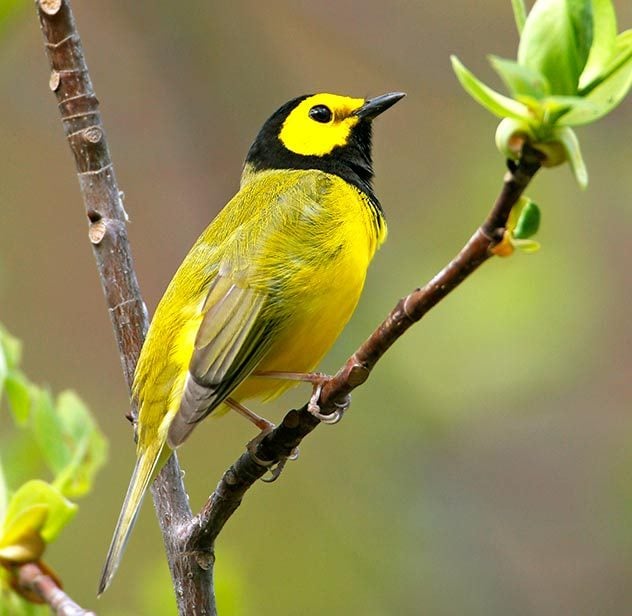
4. Hooded Warbler
Unlike other treetop loving warblers, the hooded warbler forages, and even nests, close to the ground. On the males, a black hood around a yellow face helps with ID. Look for these birds in their ideal habitat—shady undergrowth in the southeast and northeast during summer breeding season.
Marvel at jaw-dropping photos of the brightly colored Blackburnian warbler.

5. Yellow Warbler
It’s hard to miss the brilliantly colored yellow warbler. Step outside in summer and you might hear this whistled tune: Sweet, sweet, sweet, I’m so sweet. Yellows, our most widespread warbler, sing while nesting across much of the United States and Canada, especially in shrubland and woodland thickets. Females are pale lemon in color, while the males sport bold orange streaks along their chests. One of the most common of the 50 warbler species, you won’t have to go deep into the forest to see one. Yellows can be found near open woods, streams, orchards and even roadsides.
Learn how to tell the difference between a yellow warbler vs goldfinch.

6. Black-Throated Blue Warbler
Warblers often sport yellow feathers, but the plumage of black-throated blue warblers would make a stunning prom ensemble. The formal black and white is accented with rich blues in males, white females show a blush of faint indigo. White patches in the wings remind many birders of pocket squares. Black-throated blue warblers thrive in the dense forest understory from the southern Appalachians to the Canadian Maritime Provinces and Quebec.
Don’t miss 20 photos of blue colored birds.
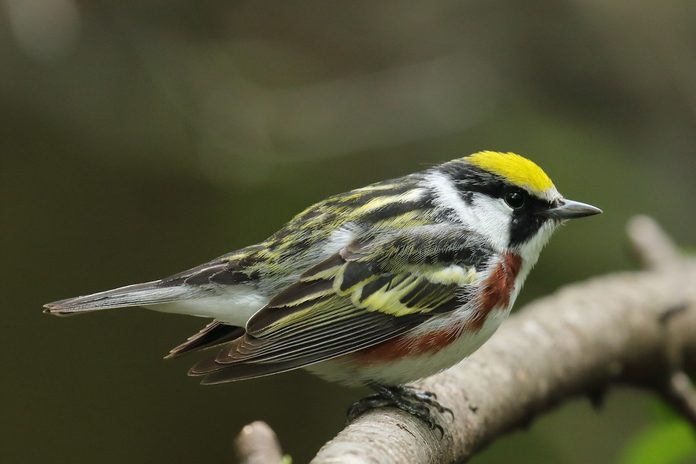
7. Chestnut-Sided Warbler
No other warbler bird sports this unique color combination. An olive-yellow cap and rufous sides make the chestnut-sided warbler a showstopper. It passes through the eastern U.S. during migration, so be on the lookout for this beauty on forest edges.
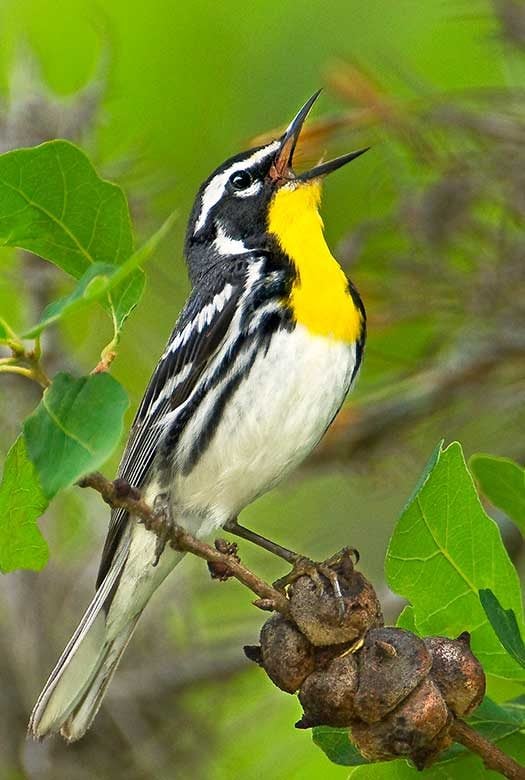
8. Yellow-Throated Warbler
The vibrant yellow throat is an important field mark. These warblers are early migrants and spend their summers in the southeastern U.S. They forage high in the canopy of swamp and pine forests.
Learn how to identify palm warblers.
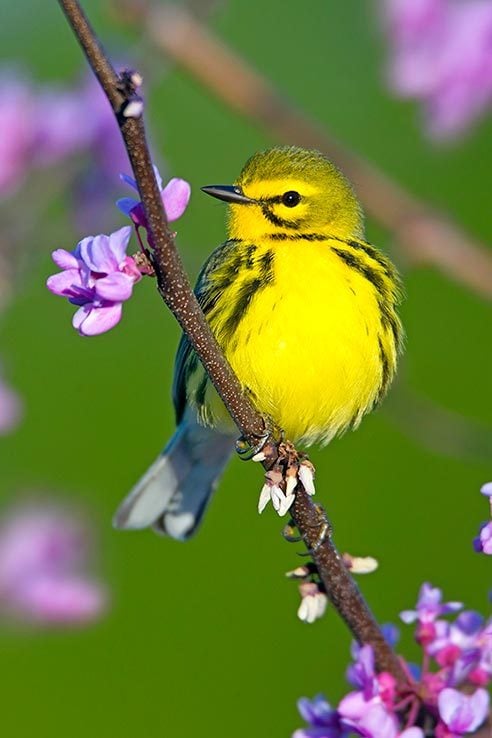
9. Prairie Warbler
Don’t let the name fool you! These streaky-faced birds prefer dense thickets throughout the eastern U.S. Males have signature chestnut-colored marks on their backs. Females have similar, though subtler, markings.
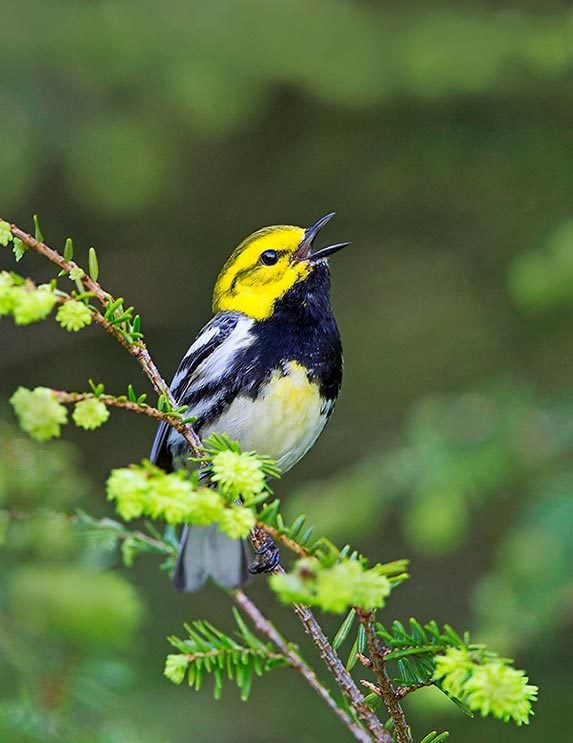
10. Black-Throated Green Warbler
Listen for the male’s recognizable song, zoo, zee, zoo zoo zee, and then look up—way up! These types of warblers stay high in coniferous or mixed forests throughout summer in the northeast. They are “green” because both males and females have olive backs.
Check out the top warbler hotspots to visit in spring.
11. Yellow-Rumped Warbler
Most warbler bird species rely heavily on bugs. But yellow-rumped warblers are sometimes enticed to suet feeders. Some of the last to head south in fall, these warblers shift to eating berries in the southern states. They return north very early in spring migration as well. Try adding water features like bird baths to the landscape to help lure these birds to your yard.

12. Black-and-White Warbler
The contrast of black-and-white warblers gives them a look of sophistication. Their methodical feeding style adds a touch of class. Black-and-white warblers mimic nuthatches by creeping along tree trunks and branches in search of invertebrate snacks. They’re widespread east of the Rockies, and a few show up in the West each year.

13. Blackpoll Warbler
Most types of warblers are long-distance migrants, but blackpolls take this to the extreme. Some of these songbirds summer in Alaska and winter in Brazil. Each weighs as much as a pen, yet in fall they complete epic journeys, flying nonstop from the eastern seaboard to northern South America. Blackpolls gorge on insects to build fat reserves to fuel their three-day trip.
Learn how to identify a Tennessee warbler and a Nashville warbler.
14. Ovenbird
Admittedly, ovenbirds don’t quite look the part. Their olive-brown backs are offset by streaks on their bellies. A splash of deep orange running along the tops of their heads gives each a racing stripe of color. Behaviorally, ovenbirds aren’t your typical warbler species, either. They spend their time foraging along the forest floor. They even build dome-shaped nests, for which they are named, directly on the ground.
Learn all about the Wilson’s warbler.
15. Kirtland’s Warbler
Only a few thousand Kirtland’s warblers are found in the world. The majority nests in jack pine forests in central Michigan, with populations expanding into Wisconsin and Ontario. Each year during migration, a few are spotted between their breeding ranges and their wintering habitats in the Bahamas.
Birding tips: Find out how to identify mystery birds.
16. Townsend’s Warbler
The West has less warbler bird diversity, but a number of species can be tracked down in the region. West of the Rocky Mountains, the stunning Townsend’s warbler is fairly common during migration. It breeds in the wet evergreen forests from Idaho to Alaska, and winters along the West Coast, inland in Arizona and Texas, and south into Mexico and Central America. Similar in appearance and closely related, hermit warblers mate and hybridize with Townsend’s where their ranges overlap.
Next, meet the cerulean warbler.
17. Lucy’s Warblers
Lucy’s warblers live in the very driest climates. Found in the desert southwest, they are one of the only warblers to nest in tree cavities. (Prothonotary warblers, also cavity nesters, live in an opposite habitat: swamps and wet forests of the East.) Lucy’s seek abandoned woodpecker holes, natural tree cavities or specially designed triangle-style nest boxes.

18. Cape May Warblers
The Cape May warbler is recognized by the thin black streaks running down its yellow chest and sides. Cape May warblers spend the summer in spruce forests of eastern Canada and the winter mostly on islands in the Caribbean. They pass through Pennsylvania and nearby regions (including Cape May, New Jersey, for which they were named) during spring and fall migrations.

19. Pine Warblers
Field marks for the pine warbler include the overall yellow color, the pattern of its face and the two whitish wing bars on dark gray wings. Also note the bird’s small size and thin bill. Pine warblers are found in Florida and elsewhere in the southeastern states all year, and in summer their range extends as far north as the southern edge of eastern Canada.

20. Blue-Winged Warblers
The blue-winged warbler gets its name from the bluish-gray color of its wings. Males sing to defend a territory and attract a mate. They croon from the tops of tall shrubs or at the edges of fields when calling to females. Listen for a raspy, unmistakable buzzing.
Next, don’t miss the 51 best spring bird pictures ever!

Harry Lauders walking stick is truly a one-of-a-kind plant. The shrub’s gnarled branches grow in a tree-like form and it offers something not many plants can boast: eye-catching traits in nearly every season.
The show starts in late winter, when not much else is happening in the garden, and progresses throughout the growing season into fall.
Create a year-round garden with these plants for all seasons.
Harry Lauders Walking Stick: Seasonal Benefits
Winter
After the leaves drop, the plant’s most prominent feature shines. Twisty brown-gray branches are an architectural sensation in chilly weather. Grown as a small tree or large shrub, there’s nothing quite like it in a winter interest garden.
Spring
The long yellow catkins appear late in early spring or late winter, depending on where you live. The dangling catkins are a great source of early spring color before many other plants start to bud.
Summer
The summer growing season may be when this plant stands out the least, but it still looks good. Large green leaves are puckered and droopy, 2 to 4 inches long, and hairy on the underside. They tend to hide the shape of the interesting branches.
Fall
Harry Lauder’s walking stick briefly bursts with autumn color before the leaves fall. Once the leaves drop, the gorgeous twisty branches are on full display again.
Looking for more orange and red in your garden? Check out the 9 best fall shrubs to grow.
How to Grow Harry Lauders Walking Stick

Here’s what you need to know before planting one of these shrubs in your yard:
- Botanical name: Corylus avellana ‘Contorta’
- Zones: 4 to 8
- Light: Full sun to part shade
- Size: 8 to 10 feet tall and wide
Once established, this shrub is fairly easy to grow. The main challenges are its disease resistance and ability to send up suckers from its roots. Keep an eye on the plant in the growing season to snip any wayward shoots and to check on the overall health of the plant.
With careful pruning, you can train the plant to take a shrub or tree-like form. Just take your time. Harry Lauder’s walking stick is slow growing, so too many cuts can leave you with a smaller plant for a while.
Also try these trees and shrubs with berries for birds.
Where to Buy Harry Lauders Walking Stick

Harry Lauders walking stick may be available at your local garden center. Give them a call to see if they have one in stock. Many online growers also offer this unique plant.
How to Grow a Hummingbird Mint Plant

- Common name: Hummingbird mint
- Agastache spp.
- Zones 4 to 11
- Size: 1 to 5 feet tall
- Full sun
- Attracts: hummingbirds, bees and butterflies
Planning your butterfly and hummingbird garden? Be sure to include some agastache. It’s no coincidence that a common name for agastache species is hummingbird mint. Hummingbirds visit the flower spikes in droves. Hummingbird mint is drought tolerant and thrives in well-draining moist to dry soils, where it grows up to 5 feet tall.
Agastache is native to North America, and no matter where you live in the U.S., you’re likely to find at least one species that will work for you. These members of the mint family are guaranteed to be magnets for hummingbirds and butterflies of all kinds. They require little care once you plant them in the right place.

Tiny tubular flowers on slender stalks grow in a variety of colors and shapes. Full sun and excellent drainage are essential for keeping plants happy. Agastache is in the same family as catnip, however, deer and rabbits leave it alone.
Check out the top 10 hummingbird plants that grow in shade.
Hummingbirds Love Hummingbird Mint
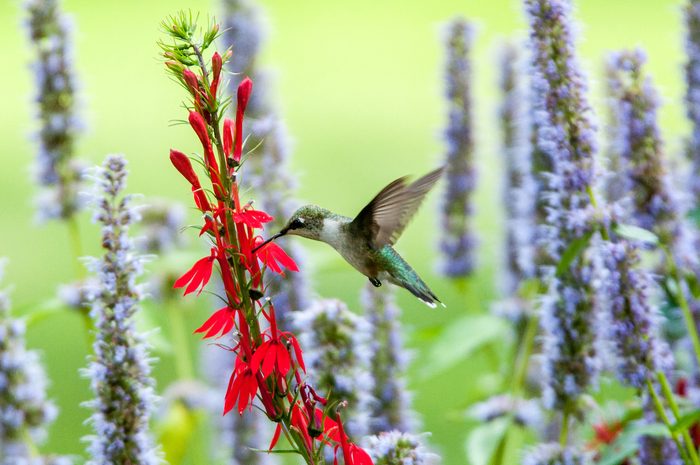
Bushy and studded with violet, orange, yellow, pink or blue flower spires from mid- to late summer, agastache is a favorite of hummingbirds, butterflies and bees. Hummingbirds register the color red very well, which is why they are drawn to bright red flowers. But hummingbirds are just as likely to visit purple blooms (and other colors) as long as they’re vibrant, tube-shaped and easily accessible.
“I took this photo of a female ruby-throated hummingbird (above) as it was sipping nectar from a cardinal flower in the perennial garden just behind our kitchen. I selected this photo for its clarity and attractive background of Blue Fortune anise hyssop, which also attracts hummingbirds,” says Sam Kulp.
Anise hyssop (Agastache foeniculum), a North American native plant, produces spikes of flowers in late summer. This wildflower releases a sweet licorice fragrance when you brush against the leaves. You’ll want to give this 2- to 4-foot plant plenty of room to spread because it readily reseeds. This species has a wide native range, covering much of the north central U.S., and is capable of growing nearly anywhere in the country. It thrives in northern, wetter climates. In warmer climates, grow it in the cool season.
Hummingbird Mint Varieties for Your Garden
Blue Fortune anise hyssop (zones 3 to 8) is a multipurpose perennial that checks all the boxes. It’s pest resistant and drought tolerant, and it flowers for months, producing clouds of pale lavender blooms. Pair it with rudbeckia or purple coneflower for an impressive late summer display of sturdy, upright blooms that continues well into fall. Its edible leaves and flowers have the fragrance and flavor of black licorice. Steep them for an aromatic cup of tea, or add them to salads and smoothies. This plant is a magnet for late season bumblebees, butterflies and other pollinators.
Gardeners in zones 6 to 9 should look for Peachie Keen anise hyssop. This brightly hued bloomer is loaded with apricot-peach flowers paired with purplish pink calyx—magnets for hummingbirds, bees and butterflies. This perennial is 2 feet tall and is often grown as an annual in colder climates. Peachie Keen has a more refined shape than other types of agastache.
Mexican giant hyssop (Agastache mexicana) is native to central Mexico. A series called ‘Acapulco’ hit the market in recent years that does well in warmer regions, including those with humid summers. Grow it as an annual in cooler climates.
Licorice mint / sunset hyssop (Agastache rupestris) is native to the hot dry regions of Arizona and New Mexico. It thrives in dry, nutrient-poor sandy soil. It will suffer in wet and humid conditions or heavy clay soil. A similar species, orange hummingbird mint (A. aurantiaca), can handle slightly wetter conditions.
Texas hummingbird mint (Agastache cana) – This native of Texas has another feature to keep in mind; some say the foliage of this plant repels mosquitoes. The crushed leaves have a minty bubblegum fragrance. Grow it in well-drained soil with regular water.
Butterflies Also Visit Agastache Plants

Butterflies also frequently indulge on hummingbird mint. “I usually take a photo of the backside of the tiger swallowtail because of the striking colors, but this photo caught my eye because of all of the details on the body. The swallowtails seem to really like the agastache I planted,” says Jackie Besser.
Next, don’t miss more long-blooming flowers for attracting butterflies and hummingbirds.

When you think of butterfly migration, it’s probably monarch butterflies that first spring to mind. Their epic journey to Mexico each year has caught the public’s imagination, especially as their overwintering grounds have become threatened. But monarchs aren’t the only butterflies that travel long distances. The painted lady also migrates, and its journey can be even more spectacular. One of the most widespread butterflies in the world, the painted lady is commonly found in North America, Europe, Africa and Asia. In the United States, its range stretches from coast to coast, from sea level to mountains and valleys. Adults feed on flower nectar, while their caterpillars eat a huge variety of host plants. They’re unable to withstand freezing temperatures, so when winter comes, painted ladies need to find warmer climates. Here’s what you need to know about the painted lady butterfly life cycle and migration.
Follow the stages of the monarch butterfly life cycle.
Painted Lady Winter Migration
“In North America, most painted ladies overwinter in Mexico,” says Jaret Daniels, who has a doctorate in entomology and is an associate professor at the University of Florida. “Monarchs also overwinter there, but in only a few small areas of mountain forest.” Painted ladies are much more spread out, preferring drier, warmer climates.
Unlike the monarch, the painted lady reproduces throughout its migrations. “Painted ladies breed along the fall migration back south,” says Jaret. “By contrast, migrating fall monarchs typically do not breed.” This means that wherever they are, painted ladies need access to the host plants their caterpillars eat throughout the year, including thistles, hollyhocks and mallows.
How does a butterfly survive winter?
Painted Lady Spring Migration

In warmer seasons, the butterflies spread across most of North America. Painted ladies are fast fliers, fluttering at speeds of up to 25 mph. They return north in the spring, breeding and spreading out to recolonize the U.S.
Painted ladies move in response to changes in the environment. They gather in such large groups for these journeys that they’ve even shown up on weather radar in a swath more than 70 miles wide! Their numbers are erratic and reflect the seasonal conditions. “In good-weather years, there can be huge numbers,” Jaret says. “In bad-weather years, usually those with poor rainfall, their numbers are lower.”
Heavy rains (often caused by El Nino weather patterns) can spark large wildflower blooms in painted ladies’ desert wintering grounds. During these conditions, the painted lady migration is an incredible sight. Low-flying clouds of the butterflies appear in gardens, along highway medians or wherever their favorite nectar plants are found. They travel in waves so large that they’re sometimes even seen on weather radars. Sometimes they make headlines, with millions flying above open country. These years are known as irruption years. It’s hard to predict when they will happen, but the number of participants is massive. During this time, painted ladies become even more widespread. This explains why some areas of the country, especially in the East, see painted ladies some years but not others.
Look for a mourning cloak butterfly in early spring.
Support the Painted Lady Butterfly Life Cycle

As butterfly habitats decline and unpredictable weather patterns create new challenges, their travels become more difficult. Those of us who love these creatures must keep doing our best to help them along the way. Gardeners can easily support painted ladies throughout their life cycle. With so much of their native habitat destroyed by development, butterflies depend more than ever on backyard gardens with host plants. Support healthy populations by making your yard the best possible wildlife habitat it can be.
“Fuel is key,” Jaret says. “Plant a diverse array of blooming plants that offer reliable nectar. Since painted ladies also breed along their route, provide host plants, too.” In addition to spring and summer flowers, plant some blooms that flower in autumn to support these migrating fliers, such as sedum, asters, lantana, bluebeard and pentas. With these easy steps, you’ll help painted lady migrations stay strong and abundant for years to come.
Helping these butterflies helps your yard, too, says Rhiannon Crain, project director for the Habitat Network, a joint project of the Nature Conservancy and the Cornell Lab of Ornithology. “Butterflies are such pivotal organisms in our backyard life cycles. They help pollinate as adults and serve as a food source for birds. Caterpillars keep plants in check even while they refresh the soil with their droppings. If you have a diversity of butterflies and moths in your garden, chances are you’re doing something right.”
How to Identify a Painted Lady Butterfly
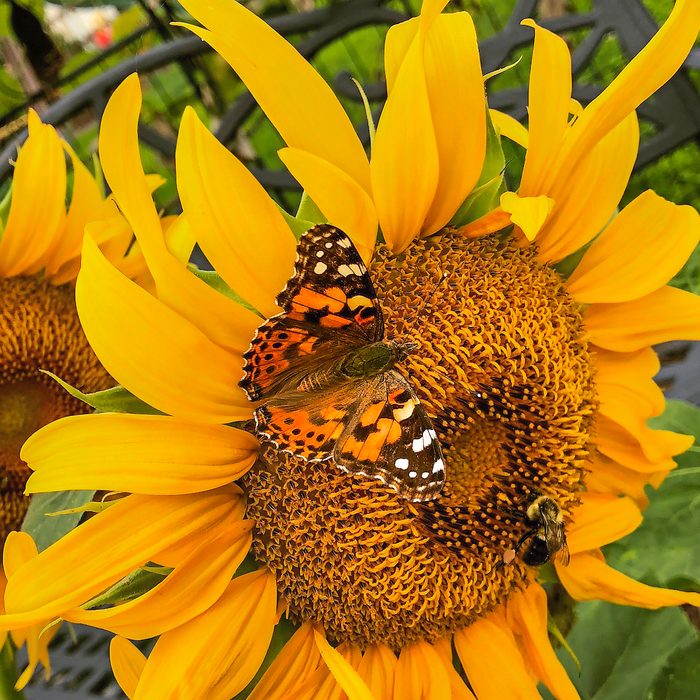
A painted lady butterfly has an orange and black patterned upper wing with white dots and four or five black dots along each hindwing. Underwings have a dark brown and tan segmented design with four or five dots on the hindwing’s edge. Their wingspan is 2 to 2 7/8 inches.
Check out 6 common swallowtail butterflies you should know.
Painted Lady Habitat
You can spot a painted lady butterfly in nearly every habitat, but they prefer open grassy areas, gardens and fields. Painted ladies live on every continent except Australia and Antarctica, and many oceanic islands. They are among the most widespread butterflies in the world!
Meet the red admiral butterfly and learn how to attract them. Plus, here’s how to identify a red-spotted purple butterfly.
Painted Lady Butterflies’ Host Plants

This butterfly uses a variety of host plants (more than 100!), but prefers thistle, hollyhock, mallow and many legumes.
Don’t miss 7 fascinating monarch butterfly facts.
What Does a Painted Lady Butterfly Eat?
You may see them sipping nectar from thistle, aster, cosmos, ironweed and blazing star. Check out more summer nectar flowers that attract butterflies, and discover how to attract butterflies in 9 easy ways.
Painted Lady Caterpillar

Painted lady caterpillars are gray-brown or almost black with a yellow stripe down their bodies and spikes along their sides and backs. They show some color variation when in caterpillar stage. Before the pupae stage, look for caterpillars creating silk tents on thistle, one of their favorite host plants.
Plant a caterpillar cafe in your butterfly garden.
Painted Lady Flight Facts

- Painted ladies can fly at speeds close to 30 miles per hour and cover up to 100 miles in a day.
- These butterflies have been found at altitudes as high as 22,000 feet, the highest of any butterfly species.
- European painted ladies migrate to Africa in fall, crossing the Mediterranean and often continuing across the Sahara Desert. Their offspring then return north to Europe in spring. Here’s how to help painted lady butterflies on their migration journey.
Next, meet garden royalty: the viceroy butterfly
Each spring, birders eagerly wait the return of so many bright and colorful birds like orioles, hummingbirds, and warblers. But, what about house wrens? Do wrens migrate? I know a lot of birders who are almost as excited to see the first house wren arrive in their backyards as they are about some of the more flashy species.
Discover 6 bird migration patterns that have changed.
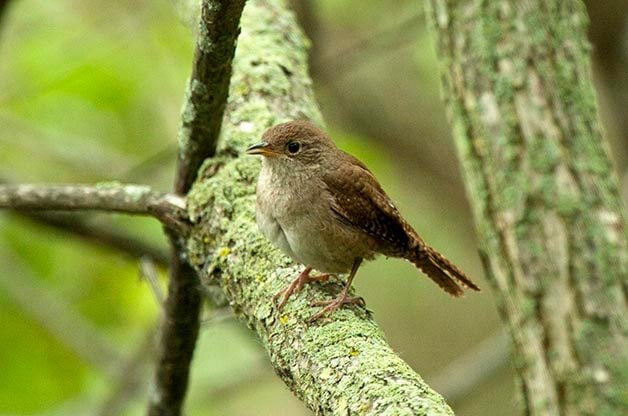
The house wren species doesn’t migrate very far, with many staying in the southern United States during the winter months. This means that they end up being a pretty early migrant, along with red-winged blackbirds and eastern phoebes. Seeing one of these birds is a sure sign of spring.
Check out 16 delightful pictures of wrens, and discover how to attract wrens to your yard.

House wrens might not be very colorful like tanagers or grosbeaks but these songbirds are known for having a beautiful song. Hear the house wren’s song.
Have you seen (or heard) a house wren in your yard yet this year?
Next, learn how to identify a Carolina wren, and check out our photo roundup of adorable baby wrens.
Socks to Save Trees
Buy a cozy pair of socks and Trees for the Future will plant 10 trees. Your feet (and the planet!) will thank you!
Pollinator Protector Activity Kit

This fun activity kit makes planting pollinator-friendly flowers simple. Just plant the included “Seed Pop” and watch purple coneflowers, wild bergamot, black-eyed Susans and other wildflowers grow. Plus, the included stickers, activity mat and patch make it a great way to teach kids about gardening.
Psst—we found great gifts for kids who love birds.
Beeswax Food Wraps
Keep your food fresh with beeswax food wraps while cutting down on single-use plastics. You’ll never need disposable plastic wrap again with this long-lasting, eco-friendly alternative.
We found gifts for bee lovers that are worth buzzing about.
Butterfly Puddler Stone
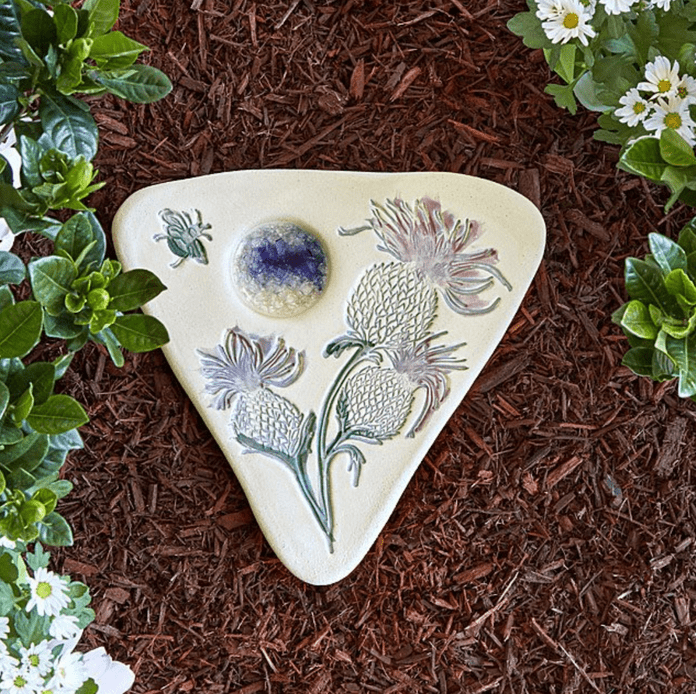
Attract more butterflies to visit your garden with this ceramic puddler stone. We love the pretty thistle design! Place this gift for earth lovers in a sunny spot surrounded by your favorite nectar flowers.
We found more unique gifts for butterfly lovers.
Funny Plastic Free Produce Bags
Keep these cotton sacks handy for trips to the grocery store and farmers’ market. The adorable veggie graphics will bring a smile to your face during every trip through the produce aisle. The bags are washable and reusable—so you can feel good about keeping disposable plastic bags out of the landfill.
We found 15 harvest-themed gifts for vegetable gardeners.
Zero Waste Shampoo Bars

Stop buying shampoo and conditioner in plastic bottles. These zero-waste shampoo and conditioner bars smell heavenly and keep your hair looking fantastic. We think they would also be a convenient choice for traveling or camping.
Looking for a fun gift for foodies? Try a mushroom growing kit!
The Naturalist’s Notebook
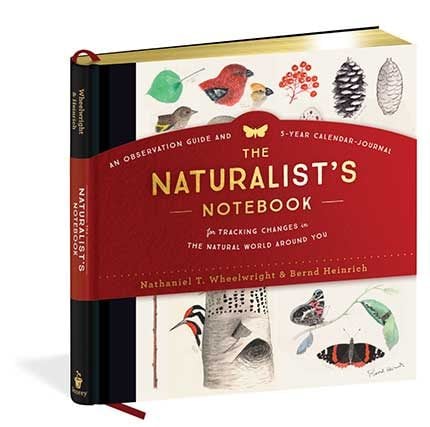
This five-year calendar helps keep track of memorable outdoor sightings to track changes in the environment. The book encourages us to record at least one observation a day.
Check out the top birding and gardening books we love.
Friendsheep Organic Eco Wool Dryer Balls
Never buy disposable dryer sheets or fabric softener again! These reusable wool dryer balls are a simply baa-dorable gift for an earth-conscious friend.
These sunflower gifts will brighten anyone’s day.
Bird Friendly Coffee
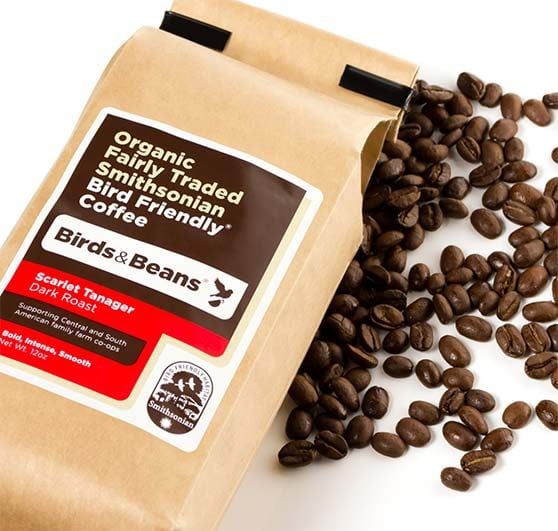
Birds & Beans coffee, grown in the tropics on songbird-friendly lands, allows you to support birds with every sip. Pair it with a cute Save the Bees mug for a complete gift.
Psst—here’s 6 easy ways to help the bees.








